- Details
-
Category: FTAs & ISDS
-
Published: Wednesday, 24 October 2012 12:33
Experts Will Assign Responsibility in Mining Case
Studies have shown that there is cyanide, iron and other heavy metals in the water
October 9, 2012-German Rivas
La Prensa Grafica
The original in Spanish can be found here
A team of specialists, made up of seven people, will investigate the cause of the cyanide and iron pollution coming from the San Sebastian gold mine (Santa Rosa de Lima, La Unión), with the goal of identifying those responsible for the pollution.
“We should not only carry out studies that look at how far-reaching this is, but also that identify actions to mitigate these effects in order to call for some measures from those responsible,” said Lina Dolores Pohl, the Vice-minister of the Environment and Natural Resources (MARN in Spanish).
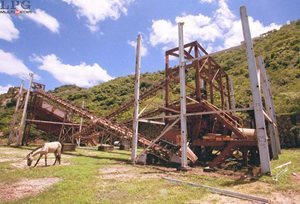 The backyard mining at the San Sebastian mine still holds the attention of the Vice-minister, after having received complaints about the pollution whose main sources is a rust colored acidic discharge that comes from the slope of the Cosigüina Mountain, where there was industrial mining for decades.
The backyard mining at the San Sebastian mine still holds the attention of the Vice-minister, after having received complaints about the pollution whose main sources is a rust colored acidic discharge that comes from the slope of the Cosigüina Mountain, where there was industrial mining for decades.
Water analysis has shown 0.45 milligrams of cyanide per liter of water, when the allowed limit is 0.05 milligrams; also, there were 393.4 milligrams of iron per liter, when the maximum limit is 0.3 milligrams per liter.
According to Pohl, the causes could originate either from the industrial mining formerly carried out by Commerce Group or by the backyard mining that is currently being done by hundreds of people that poses a risk to personal safety, including that of minors, by using explosives.
Studies carried out by the Center for Investigation of Investment and Commerce (CEICOM) in the area have determined that the water and soil are contaminated with aluminum, zinc, lead, arsenic and cadmium.
“This goes beyond the capacity of the ministry,[but] we have funding to establish a work team that will do these studies which in turn will help us clarify who is responsible so that we can act and resolve the problems in the area,” added the government official.
The funding, which totals $10,000, comes from aid given by the Republic of China (Taiwán) for environmental investigations at the MARN.
Pohl recognized that dealing with these problems is complicated, because the whole community’s source of income is the mine.
- Details
-
Category: Mining prohibition El Salvador
-
Published: Wednesday, 24 October 2012 10:51
Presentation: We Demand a Law that Bans Metallic Mining in El Salvador
San Salvador, March 5, 2012
At a forum organized by the National Roundtable against Metallic Mining in March, Dr. Angel Ibarra gave a presentation detailing the dangers and implications of metallic mining in El Salvador. This presentation is a great resource and contains information and statistics useful for education around the issue.
Below is a map of the “Gold Belt of El Salvador” which is included in the presentation.
For the full presentation see here….

- Details
-
Category: Pacific Rim/OceanaGold
-
Published: Wednesday, 24 October 2012 10:31
Economic Growth, “Development,” and the Triple Crisis: Reflections on El Salvador and Gold Mining
Robin Broad
Let me introduce myself as does my business card: I am a professor of development. I am aware that most mainstream economists – and even many so-called development professionals — define progress primarily through the lens of aggregate economic growth. Yet, my recent research in El Salvador shows why this definition of progress is wrong.
El Salvador is poor by almost any economic measure, be it per capita gross domestic product or per capita income. But a rich vein of gold lies buried beneath its mountains. This has led some prominent individuals in that country to argue that gold mining is the ticket to economic growth and therefore “development.” Former Salvadoran finance minister and mining company advisor Manuel Hinds said that renouncing mining would be “globally unprecedented” and “unjustifiable.”
This is, of course, what mainstream economic theory would have one believe.
Yet, as is often the case with field research, my travels deep into mining country in El Salvador in 2011 and 2012 and interactions with ordinary Salvadorans there revealed the reality of what “development” is and what it is not. Salvadoran farmers told me about mining executives from the Canadian firm Pacific Rim and others coming into their towns around eight years ago as mining prices started to skyrocket (gold prices have gone from under $300/ounce in 2000 to over $1,600 today). The companies promised prosperity; they said that mining was the only chance for “development.”
Read the rest of the article here…

- Details
-
Category: Mining prohibition El Salvador
-
Published: Wednesday, 24 October 2012 10:11
El Salvador mulls total ban on mining
By: Robin Oisín Llewellyn, special to mongabay.com
October 22, 2012
On hot days the broken stone and dried up silt from the San Sebastian mine in Eastern El Salvador bake in the sun. The slew of refuse is freckled with rock stained bright blue with cyanide, open to the elements that on rainier days will wash it downhill into the Rio San Sebastian below.
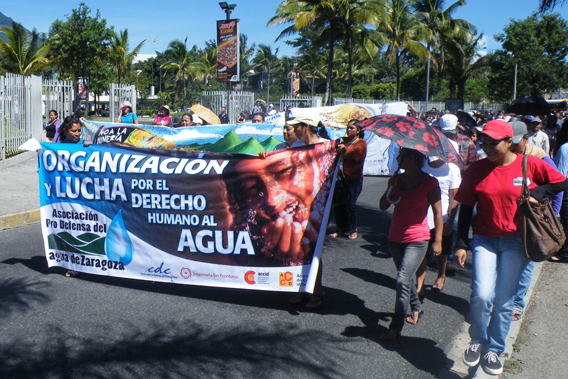
The openings of passages into the mine dot the mountainside, and further downhill a bright orange stream with a chemical stench flows into another. The American Commerce Group ceased operating here in 1999 but sought to return when the price of gold began its current escalation. After a Centre for Investigation of Investment and Commerce study found the local river to be 100,000 times more acidic than the area’s uncontaminated water, and cyanide levels to be ten times above safe levels, Commerce Group's environmental permit was revoked. The company is subsequently suing the Salvadoran government for $100 million through the Central American Free Trade Agreement.
Rising concern over the environmental impact of mining led both presidential candidates in the 2009 elections in El Salvador to pledge to suspend mining operations, a promise kept by current president Mauricio Funes. To prevent further legal cases, which are already draining millions from the country’s coffers, the Salvadoran legislature is considering a special law suspending administrative procedures related to the exploration and exploitation of metallic mining concessions.
Salvadoran environmentalists, in turn, are urging their government to go beyond the suspension of mining projects, and instead ban metallic mining altogether. Thousands of demonstrators marched through the capital this month to urge parliament to sign a law that would enshrine a "human right to water," which they said would make it impossible to grant mining permits.
Read the rest of the article here…

- Details
-
Category: Mining and Human Rights
-
Published: Monday, 24 September 2012 15:25
ADES and MUFRAS 32 and the communities of Cabañas celebrate the IV Festival for the Human Right to a Healthy Environment
By, Héctor Berrios
On September 15, 2012 women, men, young people and children yet again turned out for the IV Festival for Sovereignty and for “Our Human Right to a Healthy Environment” No to Mining!. This festival, which was first organized in 2006, is a yearly event on September 15 that combines artistic and cultural activities including painting, dance, and special speakers and is held in the plaza in San Isidro. People come from all over the municipalities of San Isidro, Sensuntepeque, Santa Marta, Victoria, Ilobasco as well as from other towns across Cabañas to sing together as one voice for life: The activity is full of Salvadorans who unite to demand life in a healthy environment with peace and justice for everyone.
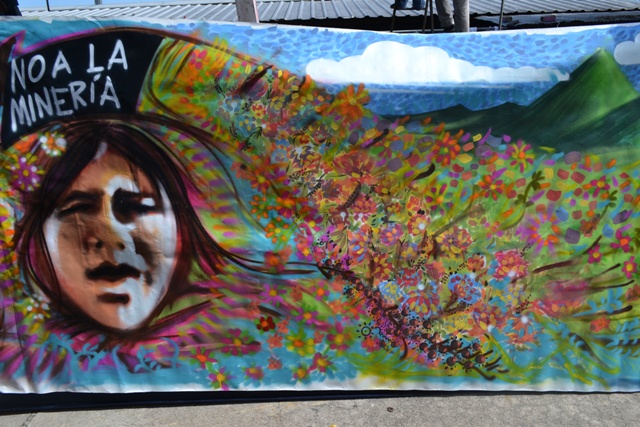
Since its beginnings, the goal of the Festival for Sovereignty has been to contribute to the resistance that defends life, water and the environment by educating and pulling together as many artists and organizers as possible. The artists take advantage of this space to show their support for human rights through music, song, dance, art, and triggering emotions in defense of the environment.
The festival looks to promote and coordinate participation from different sectors of society in the community, all of whom are concerned about the levels of contamination and environmental deterioration and who demand respect and complete respect for human and environmental rights. Along these lines, the whole population should work to preserve the ecosystem because it is the only guarantee for current and future life. Year after year the Festival for Sovereignty has grown with the support of more people helping to plan, organize and participate in the event.
The Festival begins early in the morning with activities for children, like paintings about the environment and what they think nature is and what we should protect. By using art we are able to educate and impress upon them positive outlooks towards the environment.
These types of cultural and environmental activities need to be constant until we are able to reverse the environmental problems that our country faces. Environmental problems have classified us as one of the countries most vulnerable to natural disasters in the world. Because of our geographic location we are affected by a variety of natural disasters, especially the population located in vulnerable areas. On a world level, El Salvador stands out as having 88.7% of its national territory as a “risk area” and for having the highest percentage of the population at risk.
El Salvador has been put into emergency situations due to the tectonic, volcanic and seismic activity which has brought about the loss of human life and economic setbacks. Also, our environmental reality, which includes deforestation, global warming, demographic growth and water scarcity, has brought us to a critical point that threatens the lives of future and present generations.
We are facing a reality in which we need to organize ourselves to defend life, from every ideology and political party. We have a commitment to resist and struggle against projects that bring death and are promoted with the only goal being to exploit strategic natural resources in our country. Water resources are critical. A number of reports have proven that 97% of the water in our country can be classified as average to poor quality, and only 3% of our water can be classified as average to good quality. This reality forces us to reflect on how we to revert the degradation to our ecosystems. For this reason it is important to educate ourselves to defend water and life, both of which have been threatened by gold and silver mining projects in our municipality.
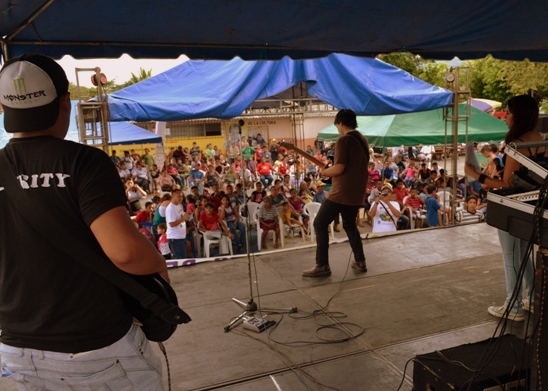
Gold mining projects have negative social and environmental impacts in communities. Mining companies, like Pacific Rim, operate huge projects that deforest the area and use thousands of liters of water during the leaching process. The water is contaminated with cyanide which later pollutes rivers, water tables, soil and the land where we plant corn, beans and vegetables. This type of industry is a threat to the very life of the community.
Gold mining has negative social impacts on the communities because it promotes divisions among the population. Transnational corporations create conflict and terror that eventually breaks down the social fabric of the community. They do not care about the wellbeing of the population, and instead only care about the economic profits they stand to earn. For this reason they do whatever it takes, including bribery in the communities and the government, as is the case with Pacific Rim. This company has sued the Salvadoran government on the international level in the International Centre for the Settlement of Investment Disputes (ICSID), which is an institution of the World Bank based in Washington. It is demanding $77 million, on top of the procedural costs which would wind up being up to $100 million, and would be paid by all of us for not allowing the company to contaminate our rivers.
The population of the Department of Cabañas, its children, its women and its youth have the right to a future. The organizations promoting this festival and accompanying the people of the region, ADES and MUFRAS-32, invite everyone to join the effort to reverse deforestation and loss of bio-diversity, and to reverse this reality. Economic, social, cultural and environmental rights need to be respected. Specifically, the authorities need to recognize and defend these rights.
We are witnessing an awaking in the social environmental movement, a movement that is willing to struggle and demand, in the first place, the end to neoliberal policies, but to also demand consistency, and more than an official discourse, demand a law that bans metallic mining.
We are sending a message to all of those who have the responsibility as well as the local and national authority to preserve and protect the environment and the rivers of our department from the threats of mining projects and the pollution resulting from large-scale hog farms.
- Details
-
Category: Cerro Blanco
-
Published: Tuesday, 11 September 2012 14:30
Guatemalan Mine Threatens the Lempa River
The Lempa River is the main source of surface water in El Salvador and provides drinking water for over 60% of the entire population, including the city of San Salvador. Recently, the Guatemalan government approved the permits for the Cerro Blanco mine: a mine is located a short 14 km from the main source of the Lempa, the Guija Lake. The Guija Lake is a natural border between Guatemala and El Salvador and part of 1,500 km of protected UN Biosphere Reserve that encompassed parts of Guatemala, El Salvador and Honduras.

The Guija Lake is not only the major water source for the Lempa River, but also an important source of income for at least 11 communities of subsistence fishermen that live on the El Salvador side of the lake. Some experts estimate that thousands of Salvadorans the main source of income for would be affected if the lake is contaminated.
This situation led the Salvadoran Vice President, Salvador Sanchez Cerén, to criticize the Guatemalan government in July saying “this cannot be polluted, it’s a region where we are three countries, its protection is fundamental.” Guatemalan President Otto Perez responded to the statement by claiming there has not been any contamination in the area because there are no active mines. What he did not mention was that the construction stage of the Cerro Blanco mine is underway and as part of that process the mining company is pumping and disposing of geothermal water found at the mining site, which could have a damaging effect on the environment if the water is not processed correctly.
Entre Mares, a subsidiary of the Canadian gold mining giant Gold Corp., owns the Cerro Blanco mine. Gold Corp has been strongly criticized throughout Latin America for the environmental destruction, health problems and social conflict created by its mines.
Environmental Impact Study found Inadequate
This month, a review of the mine’s Environmental Impact Study, done by mining and environmental engineer Robert Robinson, found an alarming number of potentially dangerous problems with the proposed mine. One of the main conclusions of Robinson’s review was: “The presence of very toxic arsenic in the soil, rock, surface water, and groundwater. Mining will likely increase the toxic concentrations of arsenic.”
His review also outlines the inadequacies in the Environmental Impact Study including lack of information, lack of planning and structures to mitigate potential environmental effects, as well as inadequate planning for contaminated water treatment. Robinson criticizes that the study “may seriously understate the possible risks of acid-generating rock,” which is the main source of pollution in the San Sebastian mining in El Salvador, as well as the time it will require to close the mine. He finishes by pointing out that after taxes, royalties and investment Gold Corp will take 74% of the profits of the Cerro Blanco mine out of the country.
Robinson very clearly states that “given the toxic arsenic (plus other toxic metals) and the inadequate EIA, the proposed Cerro Blanco mine should not be granted an exploitation license” and that “the high arsenic risks and inadequate EIA seem little incentive to approve a mine that leaves little economic gain for Guatemala.“
For more details see the complete English version of Robinson’s review (or the Spanish version).
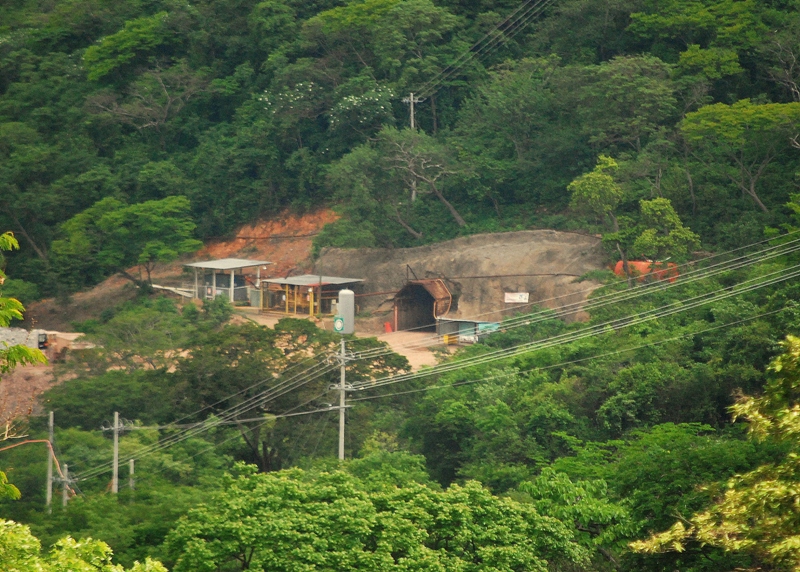
 The backyard mining at the San Sebastian mine still holds the attention of the Vice-minister, after having received complaints about the pollution whose main sources is a rust colored acidic discharge that comes from the slope of the Cosigüina Mountain, where there was industrial mining for decades.
The backyard mining at the San Sebastian mine still holds the attention of the Vice-minister, after having received complaints about the pollution whose main sources is a rust colored acidic discharge that comes from the slope of the Cosigüina Mountain, where there was industrial mining for decades.







